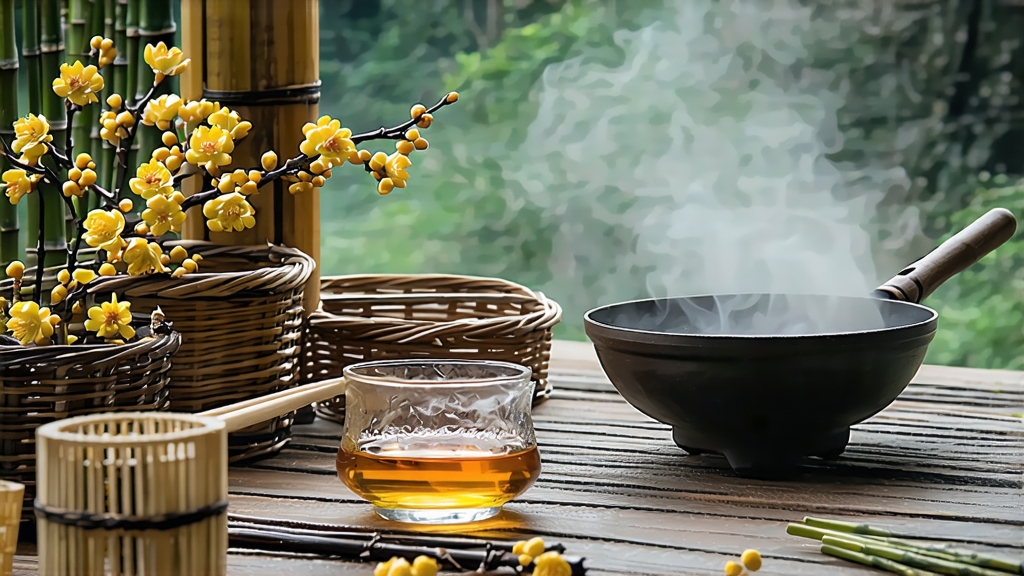
Tucked high in the mist-veiled Dabie Mountains of western Anhui Province, Huoshan Huangya has quietly embodied the elegance of Chinese yellow tea for more than fourteen centuries. While green tea commands global fame and pu-erh dominates investment portfolios, yellow tea remains the least exported, most misunderstood, and arguably the most refined of China’s six great tea families. Among the handful of authentic yellow teas still hand-crafted each spring, Huoshan Huangya—literally “Yellow Buds of Huoshan”—stands as the style’s historical benchmark, once pressed into dragon-shaped cakes and rushed by courier to the Tang-dynasty court. Today only 300 mu (about 20 hectares) of the original “golden buds” gardens survive, clinging to slopes above the Huoshan reservoir where cool nights and mineral-rich granite soils coax the tea bushes into producing extraordinarily tender, amino-laden shoots. To taste a properly finished batch is to sip liquid topaz that carries the scent of magnolia, steamed pumpkin and warm bamboo, a flavor arc impossible to replicate outside its microclimate.
History and tribute status
The first written record appears in the Shennong Bencaojing of the Han era, but concrete tribute documentation begins in Tang dynasty Kaiyuan chronicles (713–741 CE) describing “Huozhou yellow tablets, sealed with silver foil, presented at the winter solstice.” By Song times the tea had evolved from compressed cakes to loose buds, and Ming scholars praised its “three yellows”—yellow garden soil, yellow-green fresh leaf, and brilliant yellow infusion. Qing emperors favored it for fasting rituals because its gentle stomach-soothing character did not disturb meditation. After the fall of the imperial system in 1911, demand collapsed; many gardens were replanted with drought-resistant maize. A small revival began in 1972 when Premier Zhou Enlai requested 5 kg for diplomatic gifts to Japanese envoys, yet even now annual production rarely exceeds 1.2 metric tons, making authentic Huoshan Huangya rarer per gram than silver.
Cultivar and picking standards
Only two clonal shrubs are sanctioned by the Huoshan Agricultural Bureau: the traditional “Huoshan early bud” (local code HS-9) and the slower-growing “Dabie one-tip” (DB-3). Picking occurs during the fifteen-day “grain rain” window around April 20 when each bud reaches 15–20 mm, still unopened and sheathed in a faint down that reflects light like peach fuzz. The ideal pluck is “one bud just kissing its first leaf,” weighing 0.15 g apiece; experienced pickers gather barely 400 g per hour. Leaves must reach the village workshop within two hours before dawn dew evaporates, a logistical ballet involving head-lamps, bamboo baskets lined with fresh banana leaves, and motorcycles navigating switchbacks cloaked in cloud.
Crafting yellow: the menhuang miracle
What separates yellow tea from green is the extra “sealing yellow” (menhuang) step, a controlled post-oxidation that gently yellows chlorophyll while converting catechins into softer theaflavins. The process is perilous: too little enzymatic activity yields grassy green tea; too much slips into black. Huoshan masters divide menhuang into three micro-stages. First, high-temperature shaqing (kill-green) is performed on a cast-iron wok heated to 160 °C; buds are tossed by hand for 90 seconds until leaf temperature hits 85 °C, just enough to halt oxidative enzymes while preserving a 7 % moisture core. Second, while leaves are still scalding, they are piled in a bamboo drum lined with wet linen; residual heat and humidity trigger 4–6 h of non-enzymatic browning. The master checks every 20 min, fluffing the pile to aerate and redistribute heat gradients. Finally, a low 60 °C charcoal bake for 40 minutes fixes the newly formed yellow pigments and reduces moisture to 5 %. The result is a leaf that has “borrowed the color of late autumn, yet keeps the soul of spring,” as one octogenarian tea maker poetically claims.
Grades and nomenclature
Commercial grades follow a bud-to-leaf ratio and harvest date matrix. Pre-Qingming buds (before April 5) become “Special Grade A,” producing a liqueur so pale it resembles white wine yet coats the palate like custard. Grain-r